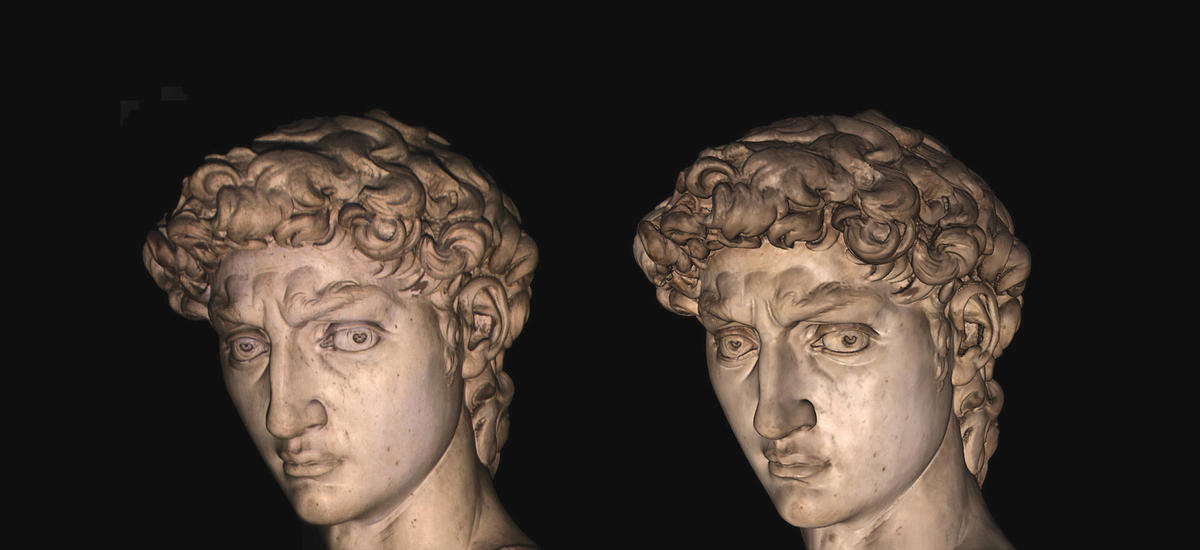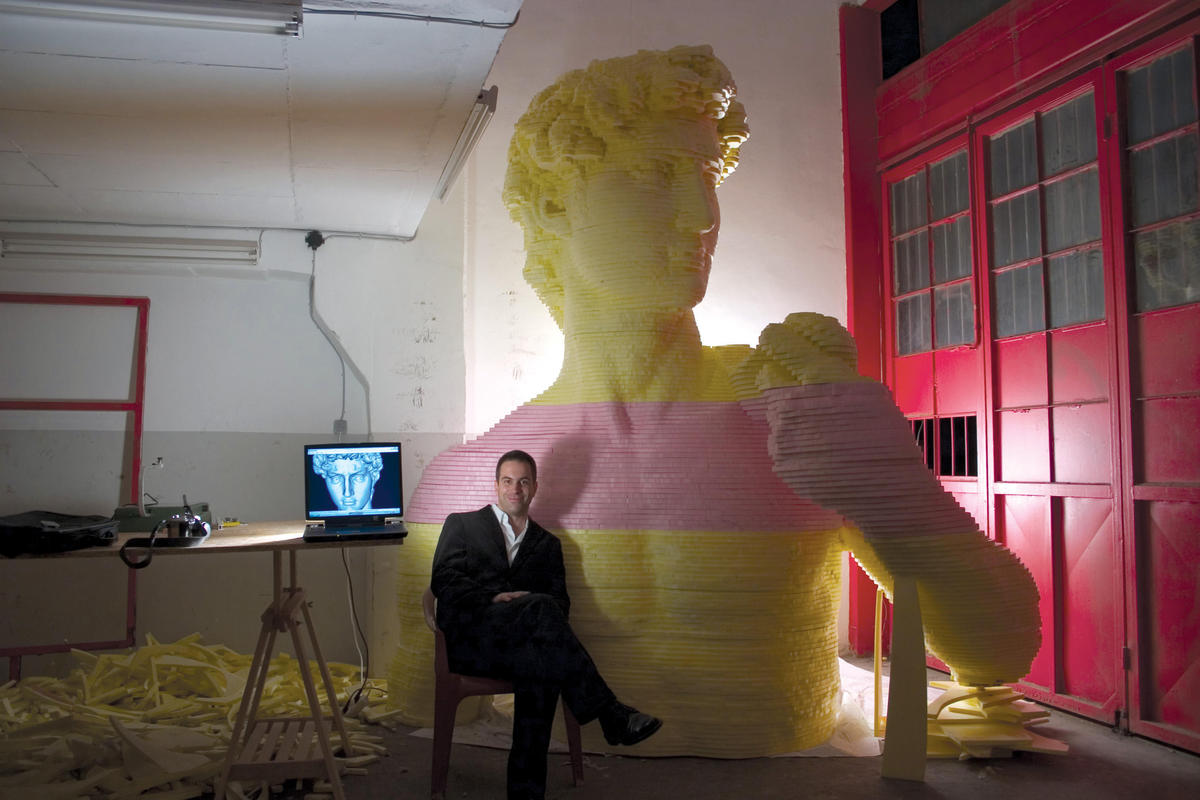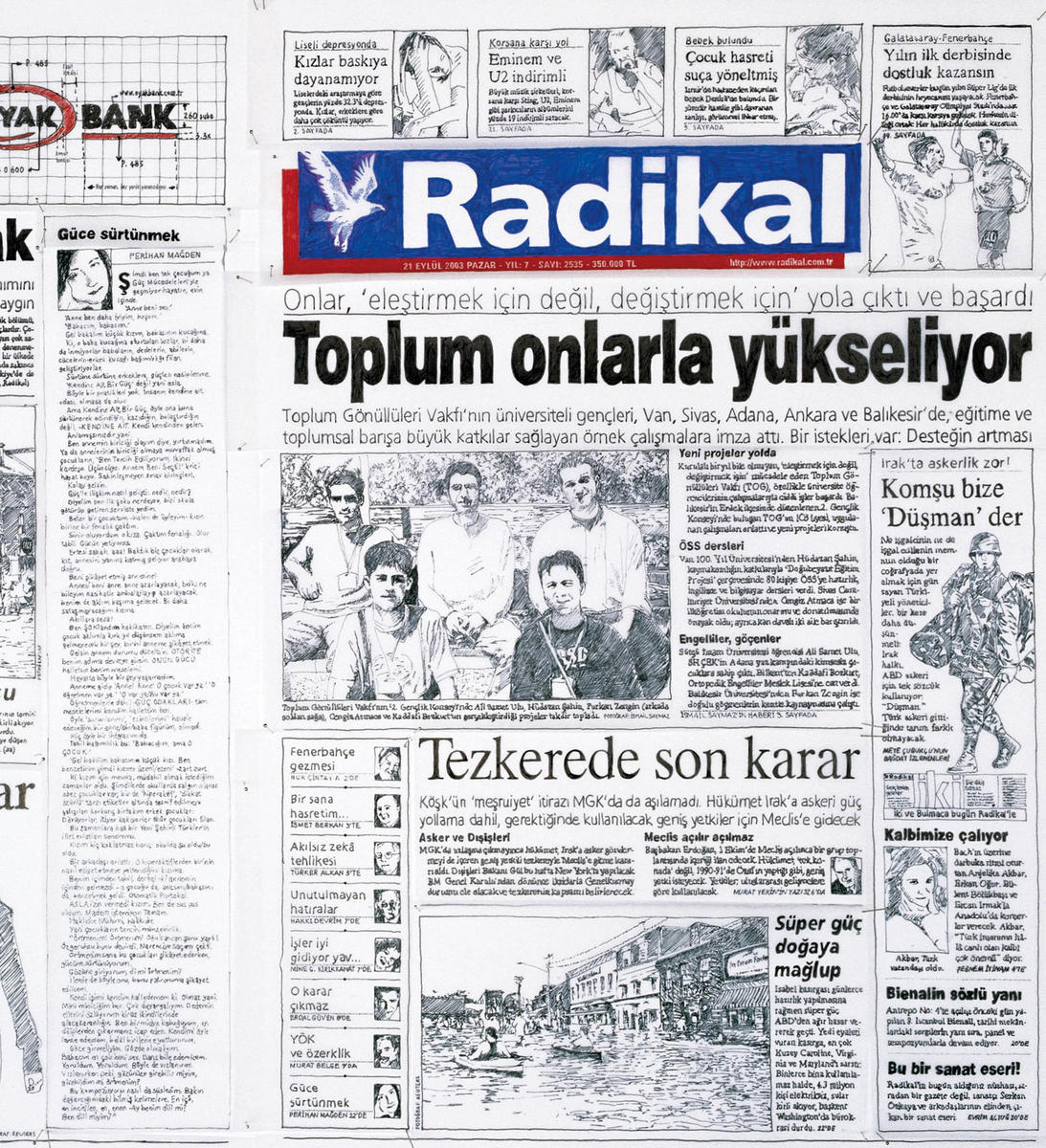
Serkan Özkaya can remember copying important works of contemporary art from an early age. With no international art collection of note in Istanbul and no option to travel to see the originals, he relied on photocopies from books, from which he would make a copy of his own. Reproductions were for Özkaya and other artists of his generation more important than the original could ever be. The prospect of seeing an original became a form of back-up and often a let-down — potentially it was smaller, less colorful, and in worse repair than ever imagined.
So Özkaya, born in 1973, has long been consumed with questions of scale and authenticity. In an endeavor to create an original from a reproduction, he once proposed to wrap the Reichstag two years after the fabric used in Christo and Jeanne-Claude’s Wrapped Reichstag (1971 to 1995) had been removed. Özkaya’s proposal to the German Parliament included copied images of Christo and Jeanne-Claude’s work. His motivation was simple — to make a work that he had never actually viewed, a work that he had only seen in pictures or heard about. He realized a similar work in Istanbul in 1997 at the BM Contemporary Art Center, where he wrote “Keith Arnatt is an Artist” on the gallery wall. Arnatt himself had performed the same gesture in a gallery in London in 1972, before Özkaya’s birth. Özkaya indicated his admiration by copying the text verbatim, making him, in his words, an art lover rather than an artist.
As these devoted acts of imitation became the focus of Özkaya’s practice, he began to consider whether the situation of living within a zone of reproduction is a representation of feeling to be in the wrong place at the wrong time. Özkaya first attributed this feeling to “geographical dislocation,” growing up and living in a country and city that many consider to be peripheral. He concluded, you always presume there is something more important happening elsewhere; “you never believe that you are in the right place at the right time, and therefore there is in fact no center.”
Triggering this moment — of ecstasy followed by clarity — for himself and others is where Michelangelo’s statue of David comes in. Özkaya has never seen the original statue; he has not even seen one of the many one-to-one casts that exist in the world. He has only encountered small replicas of the sort tourists buy and various different two-dimensional reproductions. “Such iconic works no longer exist in reality as originals,” says Özkaya. “They have become verbal legends, all about the replicas, the copies, the reconstructions and the fakes.”
Özkaya wanted to experience David first-hand, and started production of the ultimate copy, a larger-than-life replica of Michelangelo’s masterpiece, commissioned for the 9th Istanbul Biennial and to be exhibited in the area of Beyoglu. He aims to replicate that precious moment when time stands still for those who see David, many of whom, like Özkaya, only know the statue through reproductions of the work. Özkaya explains, “even if you don’t know it is in the image of Michelangelo’s statue of David, your body and eye will know that it is something beautiful. For a moment time will stand still and only in the aftermath will the obvious questions arise — is this Michelangelo’s statue of David? Is it the original, an exact copy or a new work? How was it copied, was there permission?”
In order to realize a new David, Özkaya contacted Professor Marc Levoy, known for his pioneering work in three dimensional scanning. Levoy developed a 3D laser scanner that could digitally capture an object from every angle and, from this data, a precise computer model of the original could be made. Levoy was enthusiastic to advance the potential of this technology to achieve the ability to copy in 3D a wider variety of artifacts from museum collections and sites of cultural heritage.
In 1998 Levoy and his team relocated to Florence and scanned ten sculptures in the Galleria dell’Accademia, the largest work being the statue of David. Without moving or touching the sculpture, a laser rangefinder and mechanical gantry were used to map the surface structure of David to the nearest millimeter — enough detail to detect Michelangelo’s chisel marks.
The result of this process is a data set of two billion polygons and 7000 color images — a 250 gigabyte 3D computer model of David copyrighted to Marc Levoy, Stanford University, and Galleria dell’Accademia. As long as credit is given, anyone can use the 3D computer file found at http://graphics.stanford.edu/projects/mich/ to produce a David statue in any ratio and almost any material. Other scholars have used similar technology to scan other artifacts, including the objects found in the tomb of Seti I in the Valley of Kings, Egypt, and one entire burial chamber.
Özkaya, having contacted both Levoy and the Galleria dell’Accademia out of courtesy rather than for official permission, is now making his own David based on the data of the 3D computer model. Özkaya proposes that his David will emphasize the idea that icons are considered public property, and as such, can be reproduced by anyone at will. He points out that galleries and museums provide a community model of proposed sharing; patrons form personal relationships with works of art, often returning time and again to view a specific painting or sculpture.


Another of Özkaya’s ongoing works, Mona Lisa Upside Down, also reconsiders the audience’s perception of an icon. In 1996 Özkaya wrote to the director of the Louvre and proposed that Leonardo da Vinci’s best-known work be hung upside down for “one, two, no, best for three days” in order to reconsider the paintings historical record as a thing of great beauty. Citing Roland Barthes’ work Mythologies, Özkaya believes that our understanding of icons is beyond judgment: “We accept them as such because of their long histories, and to judge for ourselves we must reposition our perspective with respect to the work in question.”
This presumed judgment also applies to defined societal objects such as the newspaper. On September 21, 2003, to coincide with the opening of the last Istanbul Biennial, Özkaya produced a work in collaboration with the daily national newspaper Radikal. On the evening before this particular issue of Radikal was due to go to press, when all the copy and images had already been laid out and the newspaper was finished and ready to print, Özkaya and his team entered Radikal’s office. Using tracing paper, they drew over every word, image and headline that appeared on the front and back page of the paper in its original form. The newspaper then went to print that night in the usual way, except for its cover, which was replaced with a printed version of the hand-drawn copy made by Özkaya and his team. Although the work was not commissioned by the Biennial, Radikal’s media sponsorship of the event meant that Özkaya’s initiative was available and free to all the exhibitions visitors. The paper was also distributed nationally as normal and available for sale at the usual price. As an afterthought Özkaya titled the work Today Could Be a Day of Historical Importance, as the newspaper had shifted from its everyday standardization to an object to be kept rather than disposed of; a copy suddenly more of a genuine article than the original.
Completed to nipple-stage at the time of our meeting, Özkaya’s David when finished will be twice the size of the original. Özkaya will paint the finished sculpture gold, adding another layer of simulated worth and excess. “I am not interested in absolute beauty, but in the beautiful as an ugly memento,” says the artist. Considering all the steps taken for this project — from the brainpower and equipment of Levoy and his team to Özkaya’s research and construction to the doubling of height and gilding — the relative value of the copy creates the potential to momentarily capture the qualities of an original, or at least a unique copy.
Can repetition in any way spoil the beauty of such an iconic work of art? Does it merely suggest that the original has lost the very essence that set it apart? With the increasing ease of precise mechanical reproduction, it is in fact the copies, replicas and fakes that authenticate the status of icons. One last question: Does Özkaya have qualms about copying, personally adapting and re-contextualizing such an icon? He is quick to answer: “I feel closer to Michelangelo in person than to the values of the museum.” And with this salvo, another iconic David enters the world.